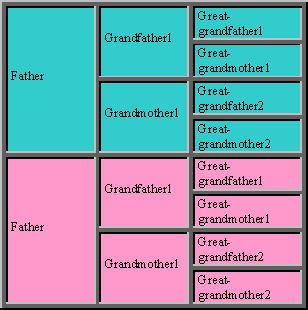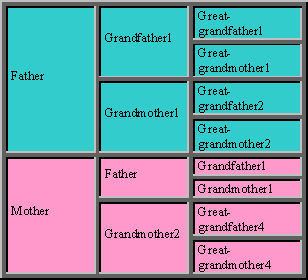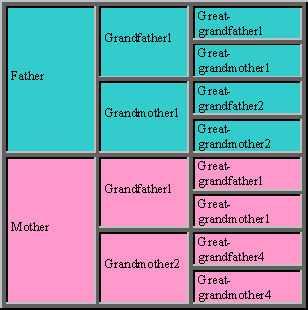The simplest method to calculate the Coefficient of Inbreeding (COI or F) is the path method. It involves determining each of the possible paths from the father to the mother that pass through a common ancestor. This identifies all the possible paths for an allele to be inherited by your puppy from both its father and its mother at the same time.
To do this, we'll use a classic pedigree diagram where the father and his ancestors are in blue, and the mother and her ancestors are in pink:

If no ancestor is in both the blue and pink parts, there is no common ancestor, and the inbreeding coefficient is zero. If an ancestor appears in both parts of the pedigree, they are a common ancestor. We must then determine each of the paths from the father to the mother that pass through them. For each of these paths, we calculate its depth (the number of individuals it contains), which we'll call N.
Each path contributes to to the total inbreeding:
(1/2)^N = 0.5x0.5x... (N times 0.5)
Therefore, you simply need to find all common ancestors, identify each path connecting the father, the common ancestor, and the mother, calculate the inbreeding contributed by each path, and then add them all together.
Did that make sense? Perhaps a few examples will help clarify...
Here, you would mate the sire 'P' with his sister 'M', resulting in inbreeding on the great-grandparents 'GP1' and 'GM1'.
Step by step explanation:
1st step: Here is the pedigree |  |
Here, we are going to marry the bitch 'M' to her father, a common case when one has got a great champion (it is the same if you marry a great champion bitch to her son).
Step by step explanation:
1st step: Here is the pedigree |  |
This is a less intense way to line-breed on a champion (in this case, the common grandfather 'GP1').
Step by step explanation:
1st step: Here is the pedigree |  |
Step by step explanation:
1st step: Here is the pedigree |  |
Step by step explanation:
1st step: Here is the pedigree |  |
Note that in the pedigree examples above, we have shown 3 generations only. We have implicitly made the hypothesis that none of the ancestors after 3 generations were related.
This assumption was useful for simple calculations, but the only way to be sure it's true would be to know all of those ancestors, which is impossible. Therefore, when you calculate an inbreeding coefficient, it is based on a given pedigree depth. The more you increase the pedigree's depth, the greater the chance of finding new common ancestors, and the higher the inbreeding coefficient will be.
From this, we can conclude that comparing two inbreeding coefficients only makes sense if their pedigree depths are equal.
If one of the common ancestors has a non-zero inbreeding coefficient, you apply the factor (1 + F) to each path that passes through that ancestor during the calculation.
In the first example (brother-sister mating), if we assume the grandfather 'GP1' already has an inbreeding coefficient of 10% (but the grandmother 'GM1' has 0%), we get:
F = (1/2)^3 * (0.1 + 1) + (1/2)^3 = 0.1375 + 0.125 = 0.2625. Thus, the inbreeding coefficient is 26.25% instead of 25%.